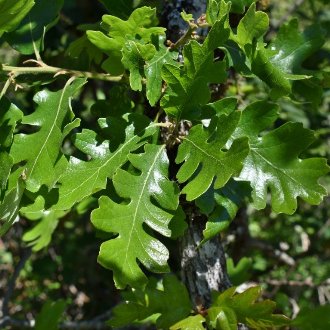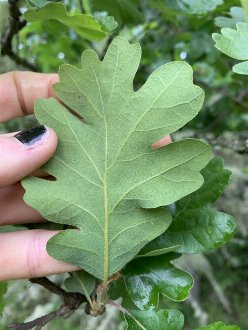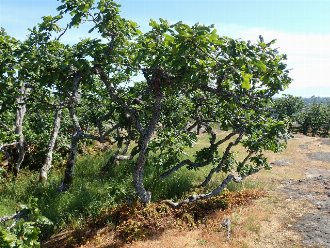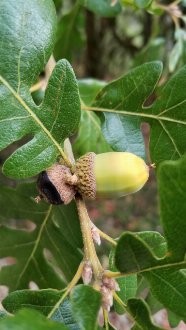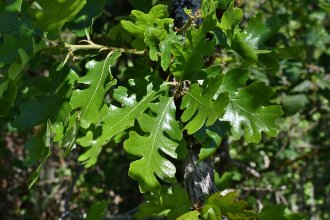Oregon White Oak (Quercus garryana Douglas ex Hook.)
Also known as Garry oak.
↑Range - Expand
| Legend | Color |
| Native | |
| Native or Not Present |
This tentative map is based on our own research. It may have limited data on Canada and/or Mexico, and there is some subjectivity in our assignment of plants as introduced vs. expanded. Read more in this blog post.
Although this plant occurs somewhere in each of these regions, it may only occur in a small part of some or all of them.
↑Habitat
This species inhabits an extraordinarily broad range of climate conditions, from sites with as little as 6.7 inches of rainfall annually, to 103.5 inches, with extreme temperatures ranging from -30° to 116°F (-34° to 47°C), and significant variation in average temperatures as well.
In most of its range, this species is restricted to sites too dry and/or exposed for other tree species, including inland valleys and foothills, south-facing slopes, exposed rocky ridges, and in the Cascades, transitional areas between high-rainfall coniferous forest to the west and treeless dissected plateau to the east.
Although it is primarily found in dry sites, it is also found in floodplains, river terraces, and heavy clay soils where there is standing water and/or a high water table during the wet season.
Found on a variety of soil types, but usually on acidic soils where a subsurface clay layer impedes drainage. Especially in higher-rainfall areas in the north of its range, mostly restricted to soils that are poor at holding moisture during the dry season. Usually found on flat to gently-sloped terrain and less common on steep slopes.
Found in forests, sometimes mixed with conifers, as well as savanna and open scrubland. In most of its range, this species is typically the first large tree to invade prairie ecosystems that have sufficient moisture to support tree growth.
Occurs in all successional stages of most of the habitats in inhabits, but absent from late-successional stages of moister habitats and habitats protected from fire, where it will be replaced by conifers and/or bigleaf maple (Acer macrophyllum).
Mostly restricted to fire-prone habitats, and depends on fire to persist in many habitats. The fire-return interval varies by different habitats, from 3 to 20 years; with much longer fire-return intervals, this species is often replaced by conifers.
↑Life Cycle
Oregon white oak is a long-lived tree or shrub.
Less is known about this species than many of the eastern oaks; it is not known how long trees take before they begin flowering and seed production. Seed production is higher for trees at least 60 years old, and may increase until as long as 80 years, after which point it levels off. Seed production year-to-year is irregular, with bumper crops some years, and varying degrees of production in other years. Unlike some oaks, individual trees are less likely to mast in sync, and in a given year it is common for as many as half the trees to produce no acorns at all, while others produce larger crops.
Seeds are distributed primarily by seed-caching animals, including both mammals and birds. Seed that is not eaten typically germinates in the first year, or dies, and this species is not thought to form a persistent seed bank. Other than predation, seeds are most likely to die if they dry out; seeds that stay moist and are not eaten nearly always germinate.
Trees can live up to 500 years.
↑Uses
Although this species is not widely grown commercially as a landscaping plant, wild trees are an important component of the landscaping in parks and urban areas. In landscaping it is able to grow on a wider variety of sites than it would occur in the wild, due to reduced competition from conifers. However, it is especially suited to sites that are dry in summer, including ones that may be flooded or poorly-drained in winter.
Like other white oaks, the wood of oregon white oak is quite desireable. It is strong, hard, close-grained, resilient, and decay-resistant. It is also easy to machine, bends well after steaming, sands well, and is relatively easy to glue and finish. However, its hardness can make it prone to splitting when using nails or screws if holes are not pre-bored. It also requires care when drying, as it is prone to acquiring defects during the drying process. Historically it was used for ships, wagons, railroad ties, and fenceposts, and nowadays is used to make furniture, flooring, railroad ties, sliced veneer, boxes, crates, pallets, and caskets. Lower quality pieces are used for pulp chips.
It can be used as firewood; it has a higher energy content than most oaks, but can be messy and can produce a large volume of ash. The bark also tends to be heavily covered in lichen and moss, which can complicate its use as firewood.
↑Related Plants
This species is probably closest-related to the leather oak (Quercus durata) and scrub oak (Quercus berberidifolia), both of which overlap in the south end of its range.
After these, it is probably next-closest-related to the channel island scrub oak (Quercus pacifica), muller oak (Quercus cornelius-mulleri), coastal sage scrub oak (Quercus dumosa), tucker oak (Quercus john-tuckeri), and blue oak (Quercus douglasii), which may share a common ancestor.
Following these it is probably next-closest related to the valley oak (Quercus lobata).
All of these closer relatives are western oaks limited to California and southward.
It is known to hybridize with four species, Q. durata, Q. dumosa, Q. douglasii, and Q. lobata. The Brewer's oak variety, Quercus garryana var. breweri, is also known to hybridize with the less-closely-related deer oak (Quercus sadleriana), and the standard variety, Quercus garryana var. garryana, is also known to hybridize with scrub oak (Quercus berberidifolia). The variety Q. garryana var. semota may intergrade with Q. lobata.
↑Notes
In contrast to the east, where oak diversity is high, this species is the only native oak in the northern part of its range, and the only oak of the white oak group in a slightly larger region. However, in the south of its range there are many oaks.
↑Links & External Resources
• Oregon White Oak | The Wood Database (About This Site)
• Oregon White Oak | Fire Effects Information System (FEIS) (About This Site)
• Quercus garryana (Oregon white oak) | USDA PLANTS Database (About This Site)
• Oregon Oak | iNaturalist (About This Site)
• Oregon White Oak | Virginia Tech Dendrology Factsheets (About This Site)
• Oregon White Oak | Silvics of North America (About This Site)
• Quercus garryana | Biota of North America Project (BONAP) (About This Site)
• Quercus garryana | NatureServe Explorer (About This Site)
• Quercus garryana | Flora of North America (About This Site)



